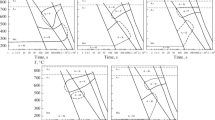Abstract
High heating rates generally characterize the thermal grinding process. Thus, during grinding, secondary surface heat treatment is observed. Notably, that the technology does not provide for this secondary heat treatment, and its modes in most cases are such that they lead to violations of the phase and structural composition of the surface layer or the so-called grinding burns of hardening and tempering. Burns lead to cracks in the surface layer of the part and reduce the reliability and durability by 3–4 times. Tempering burns occur at lower temperatures than hardening burns. Therefore they are more common. It is shown that the temperature of tempering burns is the temperature of the third transformation of tempering, and the value of this temperature depends on the chemical composition of the ground steel and the heating rate. The study made it possible to obtain mathematical dependences for determining the temperature of the tempering burns (the temperature of the third transformation of the tempering). In this work, tables of temperatures of tempering burns have been created for hypoeutectoid, eutectoid, and hypereutectoid steels at different heating rates. It is shown that the grinding modes should provide lower temperatures. The presented material shows that the temperatures of the third transformation of tempering strongly depend on the content of carbide-forming elements, particularly on the concentration of chromium.
Access this chapter
Tax calculation will be finalised at checkout
Purchases are for personal use only
Similar content being viewed by others
References
Choi, J., Lee, S.: High-frequency heat treatment of AISI 1045 specimens and current calculations of the induction heating coil using metal phase transformation simulations. Metals 10(11), 1484 (2020). https://doi.org/10.3390/met10111484
Semmler, U., Bräunig, M., Drossel, W.-G., Schmidt, G., Wittstock, V.: Thermal deformations of cutting tools: measurement and numerical simulation. Prod. Eng. Res. Devel. 8(4), 543–550 (2014). https://doi.org/10.1007/s11740-014-0538-y
Ahlers, M.: The martensitic transformation. Revista Matéria 9(3), 169–183 (2004)
Ges, A., Fornaro, O., Palacio, H.A.: Heat Treatment: Theory, Techniques and Applications. 2nd ed. Nova Science Publishers (2011)
Velling, A.: What Is Heat Treatment? Methods & Benefits. Fractory. https://fractory.com/heat-treatment-methods. Accessed 13 Feburary 2020
Pampania, J.: Heat treatment process for steel. Engineering, 19 August 2015
Dengel, B.: Heat treating carbon and alloy steels. Gear Solution, 15 October 2020
Abouelatta, O.B.: Surface roughness prediction based on cutting parameters and tool vibrations in turning operations. J. Mater. Process. Technol. 118, 269 (2001)
Usov, A., Oborskij, G.: The effect of thermomechanical phenomena on the stability of cutting process and wear of cutting tools. Superhard Mater. 6, 66–71 (2003)
Wang, L., et al.: Mechanism of grinding-induced burns and cracks in 20CrMnTi steel gears. Mater. Manuf. Process. 34(10), 1143–1150 (2019)
Li, Z.C., Ferguson, B.L., Nemkov, V., Goldstein, R., Jackowski, J., Fett, G.: Effect of steel hardenability on stress formation in an induction hardened axle shaft. In: Proceedings of HTS 2013 Conference. ASM International, ASM HTS 15 Detroit, MI (2013)
Del Re, F., Dix, M., Tagliaferri, F.: Grinding burn on hardened steel: characterization of onset mechanisms by design of experiments. Int. J. Adv. Manuf. Technol. 101(9–12), 2889–2905 (2018). https://doi.org/10.1007/s00170-018-3156-6
MacKenzie, D.S.: Metallurgical reasons for grinding cracks and their detection. Gear Solution, 25–27 May 2017
Pye, D.: What causes grind burns on carburized gear teeth? Ind. Heat., 2 March 2009
Fedoseev, O.: Analysis of tempering and rehardening for grinding of hardened steels. J. Manuf. Sci. Eng. 113(4), 388–394 (2008)
de Lima, A., Gâmbaro, L.S., Vieira Junior, M., Baptista, E.A.: The use of cylindrical grinding to produce a martensitic structure on the surface of 4340 Steel. J. Braz. Soc. Mech. Sci. & Eng. 33(1) (2011)
Lasaosa, A., Gurruchaga, K., Arizti, F., Martinez-De-Guerenu, A.: Induction hardened layer characterization and grinding burn detection by magnetic barkhausen noise analysis. J. Nondestr. Eval. 36(2), 1–7 (2017). https://doi.org/10.1007/s10921-016-0388-y
Author information
Authors and Affiliations
Corresponding author
Editor information
Editors and Affiliations
Rights and permissions
Copyright information
© 2022 The Author(s), under exclusive license to Springer Nature Switzerland AG
About this paper
Cite this paper
Lebedev, V., Chumachenko, T., Klymenko, N., Frolenkova, O. (2022). Burns of Tempering While Grinding Hardened Steels. In: Tonkonogyi, V., Ivanov, V., Trojanowska, J., Oborskyi, G., Pavlenko, I. (eds) Advanced Manufacturing Processes III. InterPartner 2021. Lecture Notes in Mechanical Engineering. Springer, Cham. https://doi.org/10.1007/978-3-030-91327-4_18
Download citation
DOI: https://doi.org/10.1007/978-3-030-91327-4_18
Published:
Publisher Name: Springer, Cham
Print ISBN: 978-3-030-91326-7
Online ISBN: 978-3-030-91327-4
eBook Packages: EngineeringEngineering (R0)




